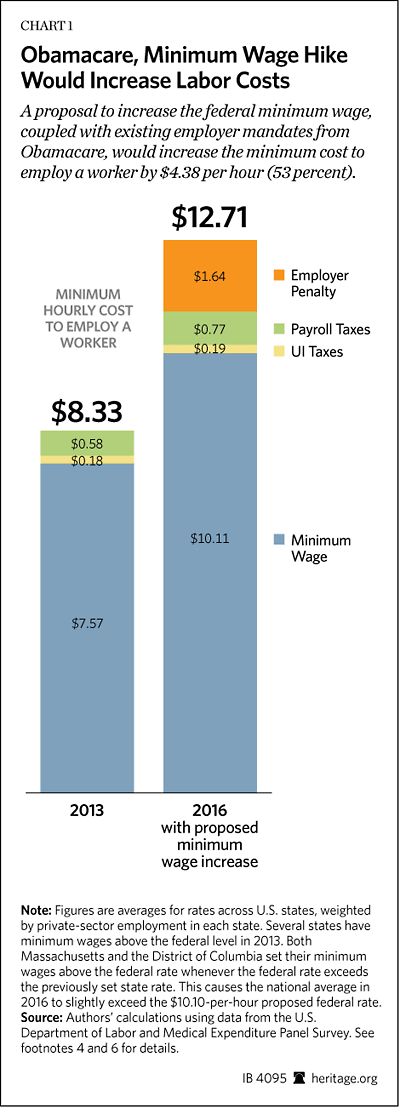The government has already effectively raised the minimum wage above $10 per hour—without benefitting workers. President Obama’s health care law requires employers to offer full-time employees health benefits that meet certain “minimum standards” criteria. Otherwise, they pay a penalty. In 2015, this mandate will raise the minimum productivity necessary to hold a full-time job to $10.30 per hour.[1] Employers will lose money if they hire employees who produce less than this amount.
The President now proposes raising the national minimum wage to $10.10 per hour. Coupled with the employer penalty and existing taxes, this would raise the minimum cost of hiring a full-time worker to $12.71 per hour. Employers would respond by eliminating jobs and cutting workers to part-time status, making it significantly more difficult for unskilled workers to get ahead.
Higher Employment Costs
Obamacare requires many employers with 50 or more employees to offer qualifying health coverage[2] to their full-time workers.[3] This health coverage is expensive. In 2015, it will add $2.24 per hour to the cost of employing a worker with single coverage.[4] Those that do not provide coverage face a fine of $2,000 per employee per year (after the first 30 workers) that comes out of after-tax dollars. This equates to a $3,279 increase in pre-tax payroll costs—$1.64 per hour.[5] The Administration has delayed the mandate’s implementation until 2015. When it takes effect, it will increase the cost of hiring unskilled workers.
These costs are on top of other government mandates. Businesses must also pay the minimum wage, the employer share of payroll taxes, and unemployment insurance (UI) taxes. Normally, businesses defray these costs by reducing workers’ wages by an offsetting amount. However, employers cannot reduce the pay of minimum-wage employees, so they must pay these payroll costs themselves or forgo hiring.
Table 1 shows minimum hourly employment costs for full-time workers in 2015, the year the employer mandate takes effect. Full-time employees with qualifying health benefits will cost their employers at least $10.92 per hour (with single coverage). Employers who opt to pay the penalty instead will nonetheless pay at least $10.30 per hour for labor.[6]
From an employer perspective, the government has already raised the minimum wage above $10 per hour. In 2015, full-time workers who produce less than $10.30 per hour will, on net, cost their employers money. This will make it much harder for inexperienced and unskilled workers to find full-time employment. Businesses will not hire workers at a loss.
Proposed Minimum Wage Hike
President Obama and some Members of Congress want to raise the minimum cost of hiring a worker even further. They support raising the minimum wage to $10.10 per hour—higher than any existing state rate—over slightly more than two years.

If this happened, by 2016, employers that provide health insurance would have to pay at least $13.27 per hour for workers with the required single health coverage. If employers pay the penalty instead, each full-time employee would still cost them at least $12.71 per hour.
Negative Consequences for Workers
These costs would make hiring unskilled workers full time uneconomical for many businesses. Relatively few workers in minimum-wage positions create over $12 per hour worth of value for their employers. In many cases, paying that much would cost businesses more money than the worker produces.
Businesses would respond by finding new ways to lower their labor costs. Part of this would involve replacing labor with capital, shifting to automated systems wherever possible. This could take many forms, such as increasing the use of the automated cashiers that have become common in stores across the country. Or it could involve the widespread adoption of newer inventions such as the Alpha, a robotic hamburger maker that cooks over 300 gourmet burgers per hour.[7] Such changes would lower labor costs by reducing overall employment.
Businesses would also look for ways to lower the labor costs of employees they do hire. It costs less for a business to pay the employer penalty than to offer inexperienced workers health care plans that are deemed “minimum essential health benefits” by Obamacare (see table), so most employers of low-wage workers would pay the fine and dump their workers onto the government health care exchanges.
Employers can further avoid the penalty for doing this by cutting employees’ hours below 30 per week. Under Obamacare, that qualifies employees as part-time workers and exempts their employers from the penalty. Many firms have already announced plans to cut hours below the Obamacare threshold.[8] When the mandate takes effect in 2015, such announcements will become widespread. This will make getting a full-time job far more difficult for unskilled workers.
Good Intentions Insufficient
President Obama may have good intentions, but this does not negate the law of unintended consequences. Minimum-wage jobs are entry-level jobs that provide unskilled workers the experience they need to become more productive and command higher pay. That is why two-thirds of minimum-wage workers earn raises within a year.[9] Working more hours helps workers earn those raises faster. Full-time minimum-wage workers are 10 percentage points more likely to earn a raise than those who work less than 20 hours per week.[10]
Requiring unskilled workers to produce at least $12.71 per hour in value for their employers to break even will make these entry-level jobs far scarcer. But inexperienced workers cannot become skilled workers without the experience and on-the-job training that entry-level jobs provide. Adding the proposed minimum wage hike to Obamacare’s employer penalty would cut the bottom rung of many disadvantaged workers’ career ladders.
—James Sherk is Senior Policy Analyst in Labor Economics and Patrick D. Tyrrell is Research Coordinator in the Center for Data Analysis at The Heritage Foundation.



